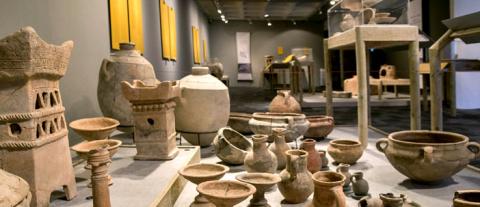Land of Honey
Numerous aspects of the rich material culture dating to this period that were revealed at this major site are presented, with an emphasis on the Canaanite background of the population, the cultural and political affiliation with the Israelite kingdom, and unique aspects of the local architecture and cultic practices. A salient feature of the Iron Age IIA city was the exclusive use of mudbrick to construct all buildings, incorporating wooden beams in walls and floors. Each building was unique in its architectural plan, and did not resemble any of the common blueprints of the Iron Age II, such as four-room houses or pillared buildings. Notable among these unique structures are Buildings CF and CP; the latter is considered to have been of a special cultic nature, containing a large amount of special items, such as two four-horned pottery altars, and a rich assemblage of domestic and cultic objects. Tel Rehov comprises the Iron Age IIA site with the most inscriptions found to date, including two that mention the name "Nimshi", the father or grandfather of Jehu, who usurped the kingship from the Omride dynasty (2 Kings 9), as well as a rare ostracon with the name Elisha in red ink, found in the cultic Building CP. An open-air sanctuary unearthed in the eastern part of the mound, included a platform and massebot (standing stones), is a unique example of such a sanctuary in Ancient Israel. All of these intriguing objects, as well as numerous others, are presented in the exhibition, within the cultural and social context of Iron Age II northern Israel.
The highlight of the exhibition is the well-preserved, industrial-scope apiary found at Tel Rehov, dated to ca. 900 BCE, which is the only such facility ever found in an archaeological excavation. The apiary is presented along with textual evidence of beekeeping in ancient Egypt and Anatolia, ethnographic practices in modern times that are strikingly similar to ancient methods. Remains of bees found in charred honeycombs were identified as Anatolian bees, which are foreign to the Land of Israel. This discovery has important implications for the possible existence of sophisticated trade relations between Anatolia and northern Israel at that time. The apiary that operated at Tel Reḥov almost 3,000 years ago shows that the biblical term honey was not merely a syrup produced from fruits, as had been commonly accepted, but bee's honey, not only collected in nature, but the product of sophisticated beekeeping, an important economic branch in the First Temple period.
These unique and unprecedented discoveries make Tel Reḥov one of the most important and intriguing sites in the study of ancient Israel during the 10th-9th centuries BCE.
Curator: Dr. Irit Ziffer
Closes: October 30, 2016
All the exhibits are on loan from the Israel Antiquities Authority.

